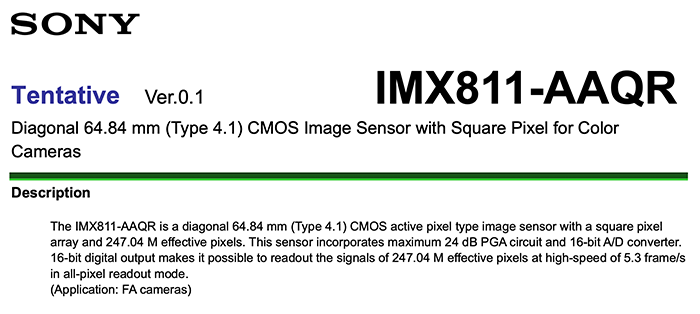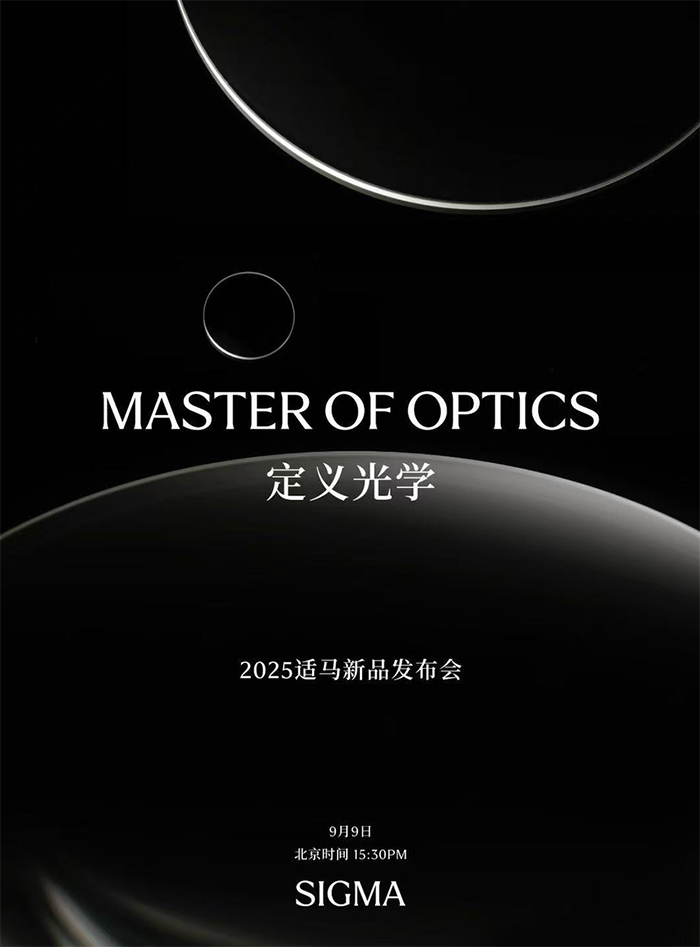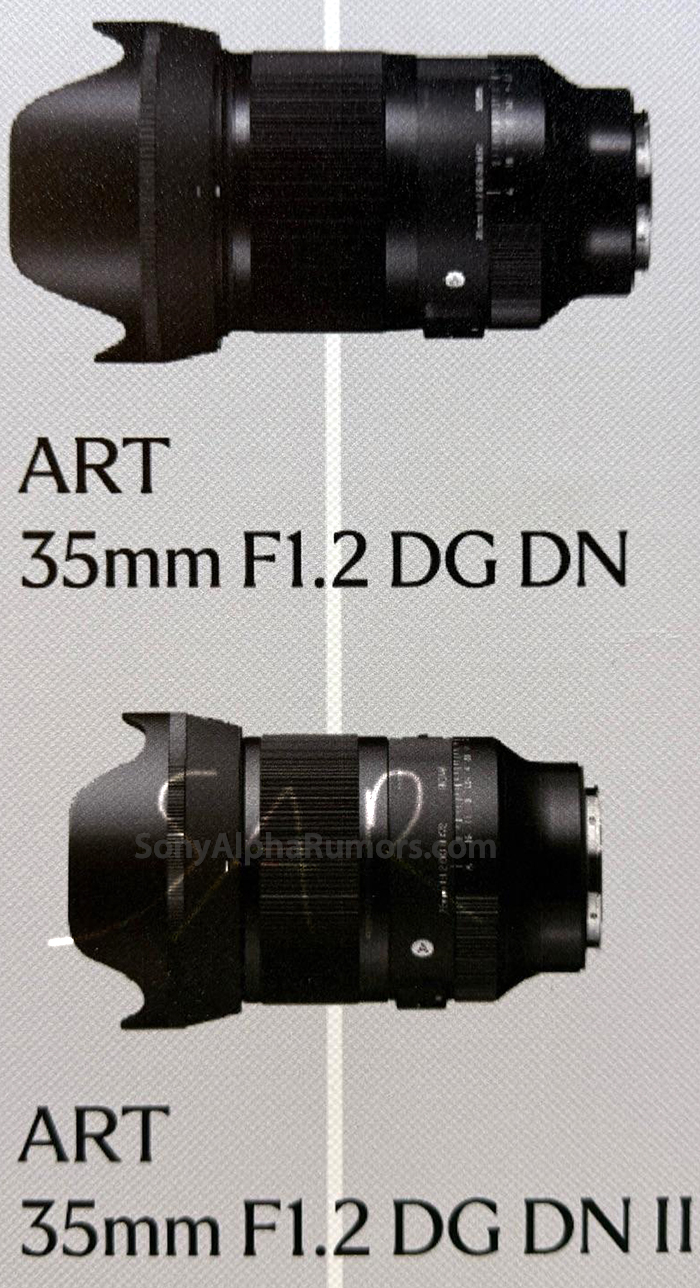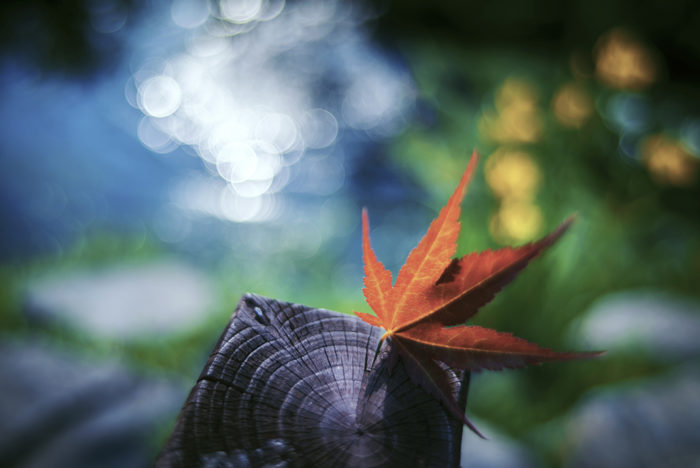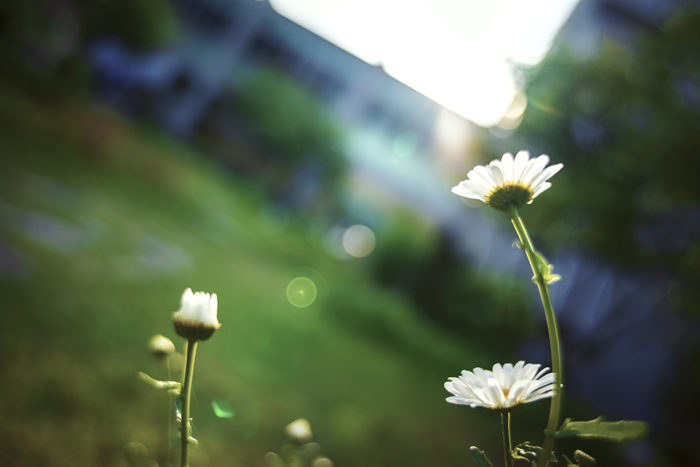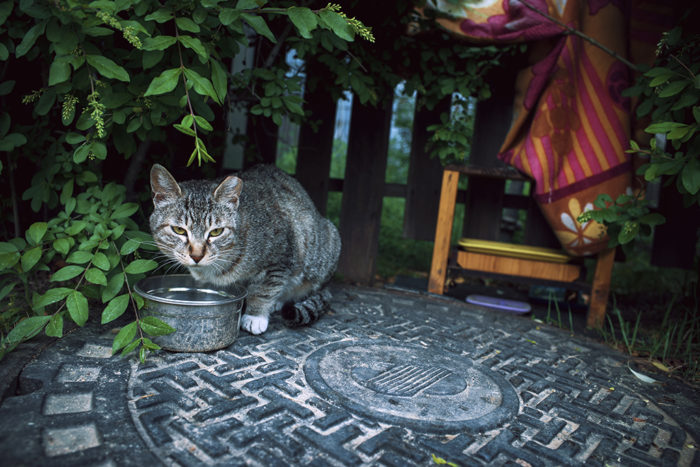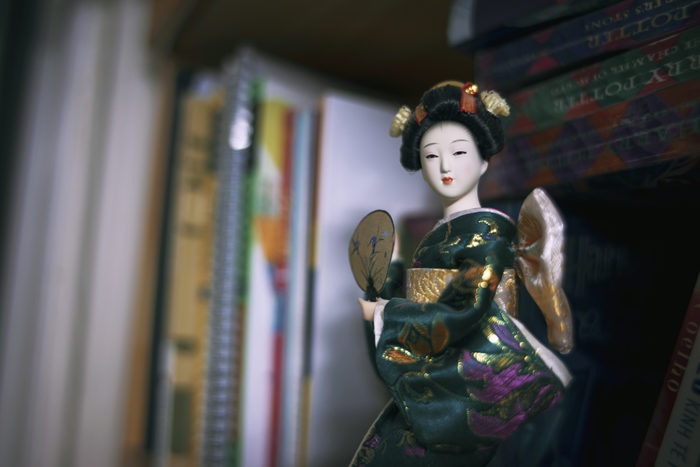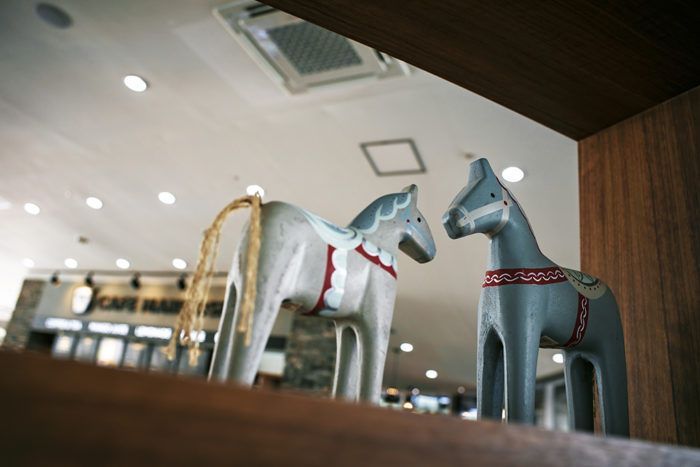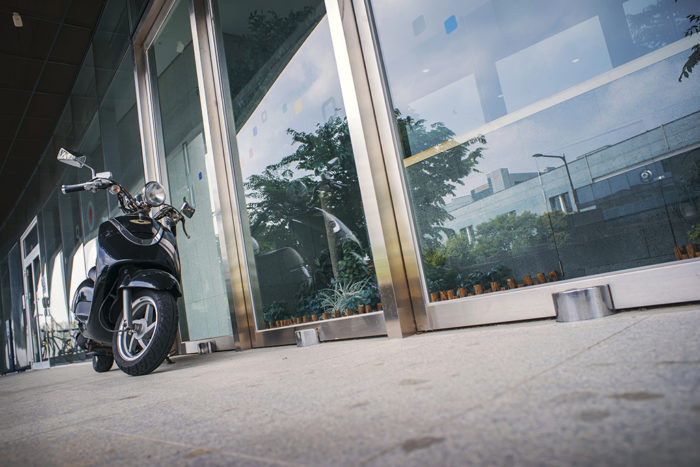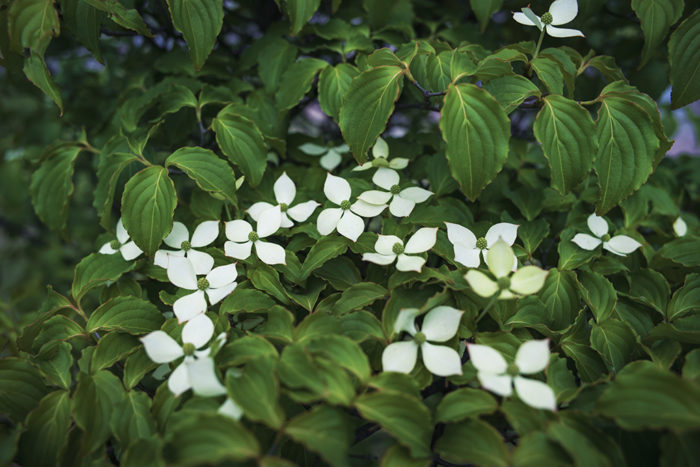SLR Magic 25mm f/1.4 CINE – review and comparisons
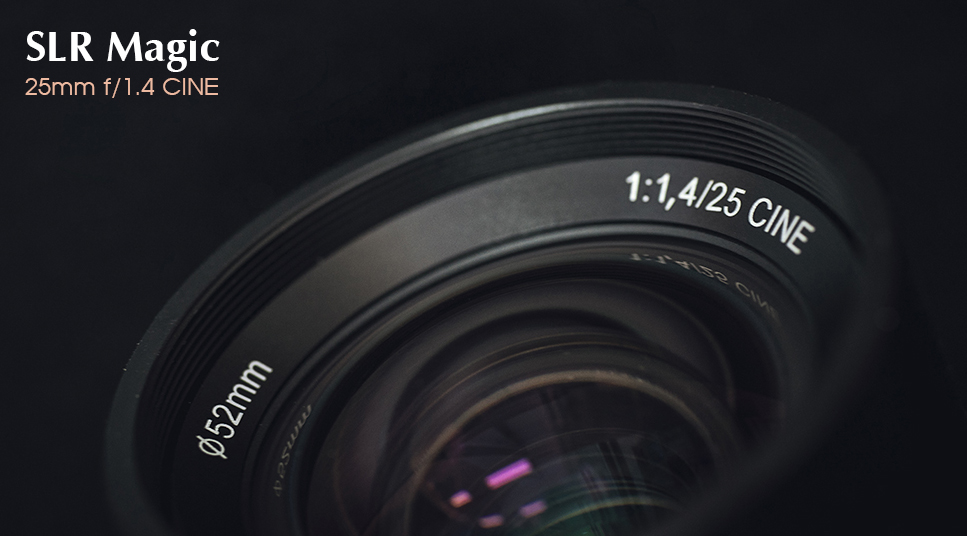
This is a Guest Post:
—
Hello, my name is Le Minh Bui a.k.a. Langstrum.
I shared few of my reviews before on SAR, and today I want to publish my in-depth review of SLR Magic 25mm f/1.4 Cine lens. Since I volunteered for the lens reviewing program, I got the lens early from the company. The reason I’m interested in this lens is the need of a compact, wide and fast lens for my A7ii. There are some other choices but most of them are DSLR type, hence very huge in size, which is not comfortable for me to carry in my bag when I travel. I already had Sony FE 28mm f/2 and Canon FD 24mm f/2, they fit to my parameters, but they’re not fast and focus closely enough to produce nice close up photos or for general low light photography. Well, on paper the SLR Magic 25mm f/1.4 seems to be a nice alternative, and it’s a cine lens that I can use for video whenever I need.
In this review, I mainly focus on SLR Magic lens and in some parts I will throw in the comparisons with the other two lenses, since it’s easier to evaluate the performance based on something is already known.
1. TECHNICAL SPECIFICATIONS
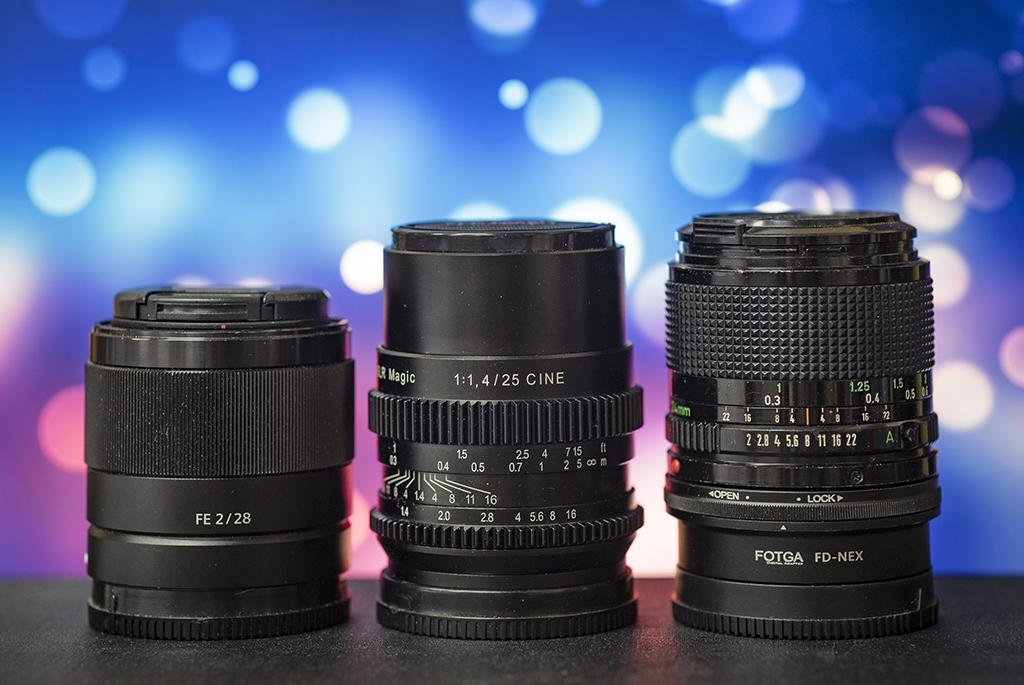
First, let’s see how there lenses were designed. You can see that the SLR Magic is the heaviest one (almost double the weight of FE 28mm) while it’s not significantly bigger. Considering it’s 3 mm wider than the FE and 1 stop faster than both FE and FD lenses, I must say it’s a really compact lens. SLR Magic lens can focus closer than the other two (about 5 cm closer) and offers lots of aperture blades (13 versus 9 and 6) to ensure round bokeh with every aperture settings. In term of optical design, SLR Magic 25mm is constructed from 11 elements in 9 groups, which appears to be more sophisticated than FE 28mm f/2 with 9 elements in 8 groups. However, SLR Magic lens lacks of special elements for improving image quality and correcting optical aberrations, and surprisingly, the 30 year old FD 24mm f/2 has an equal number of 11 elements, including a floating element for improving performance at close focus distance. This FD 24mm even outperformed FD 24mm f/1.4 L in some reviews so it’s worth to put in this test. You can find more details about these lenses in the table below.
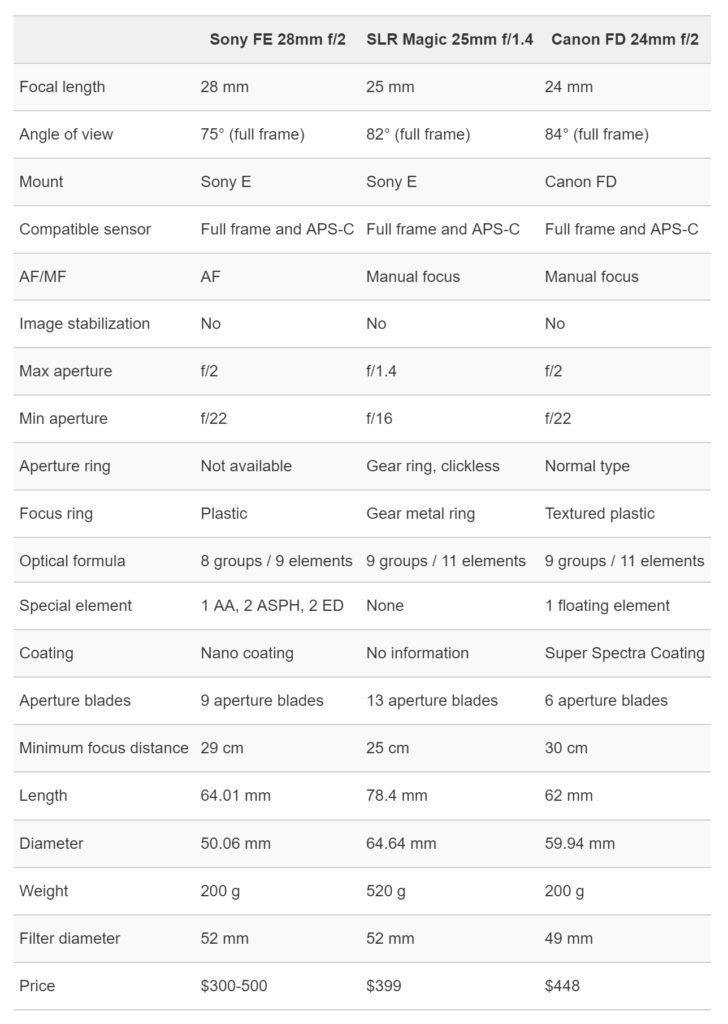
2. SLR MAGIC 25MM F/1.4 HANDLING AND FEATURES
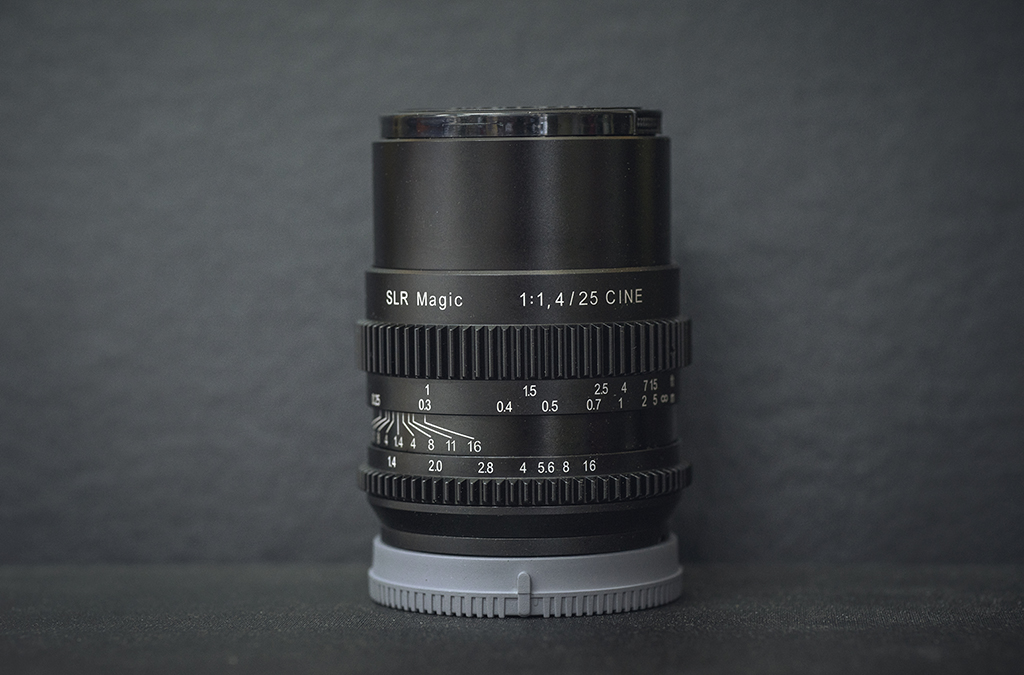
SLR Magic focuses on producing compact cine lens with fast speed to be used on mirrorless cameras like Sony E, Fujifilm X and Micro Four Thirds. The way they designed and produced cine lenses, such as the 50mm f/1.1, 75mm f/1.4, 35mm f/1.2, seems to be very consistent. I was surprised when I got the lens, it’s small, very well built and heavy (in a good way)! The lens is made from metal, with a gear type aperture and focus ring for coupling with follow focus systems. The focus ring needs to turn about 60 degree to change the focus from the minimum focus distance (25 cm or 9.8″) to infinity, and I just wish that it’s a bit more to focus more accurately. For still photography, maybe some people will not be happy with the gear type rings, but I’ve adapted to them since I used Samyang cine lenses so it’s fine. Both the rings are well dampened, smooth, but they need a bit more force than normal manual focus lenses to rotate, especially the aperture ring. Also, the aperture ring is click-less, which means it doesn’t make any sound when you change the aperture, as it’s a cine lens. Normally it’s also not a problem to me, but during the period that I tested the lens, I always have to check the aperture marking to make sure I set it correctly. However, the good side is I never turned them by mistake. One more nice thing about this lens is the snap-on lens cap, as it’s very tight and I never had to worry if the cap can slip out.
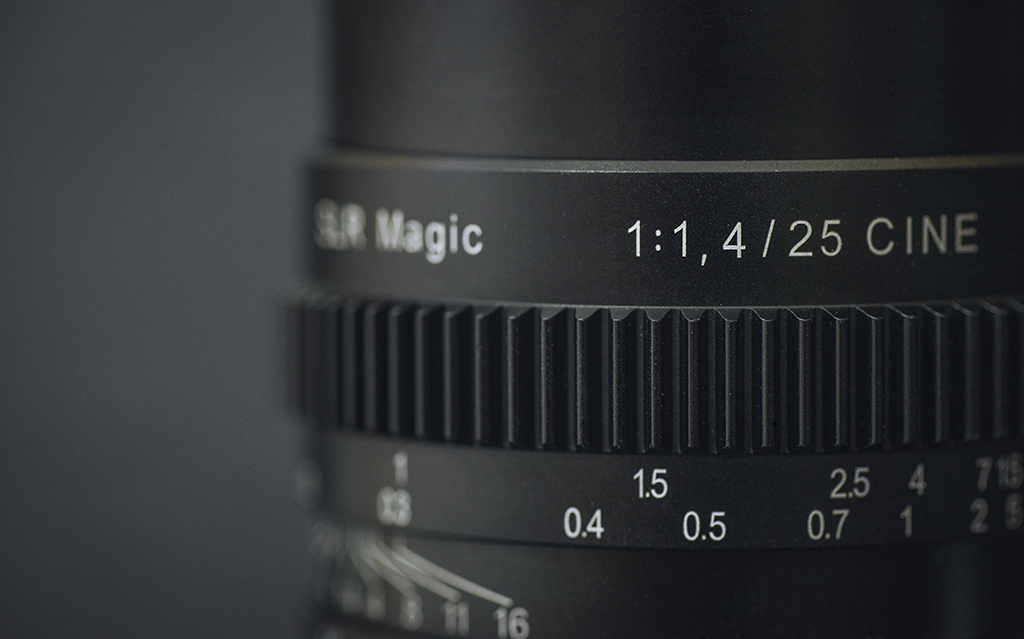
On my Sony A7ii, even though the lens is small, it’s not balanced well and the camera is prone to fall to the front. I don’t complain about that, considering that most of the wide, fast lenses out there are in the same situation, but you need to take caution since it’s easy that the front rim of the lens can be scratched by falling to the ground.
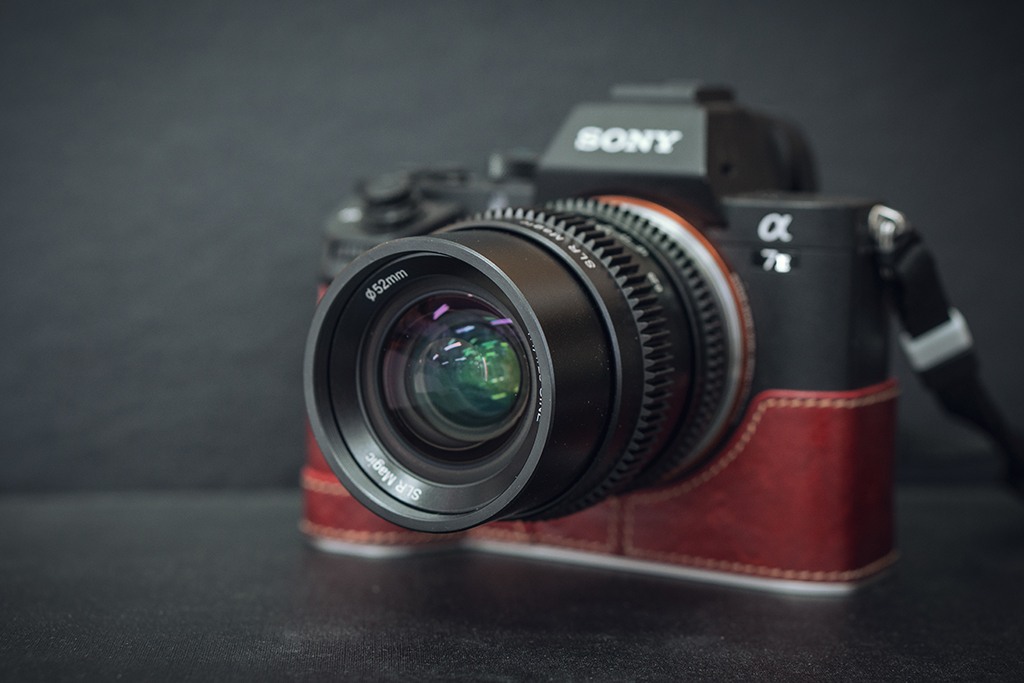
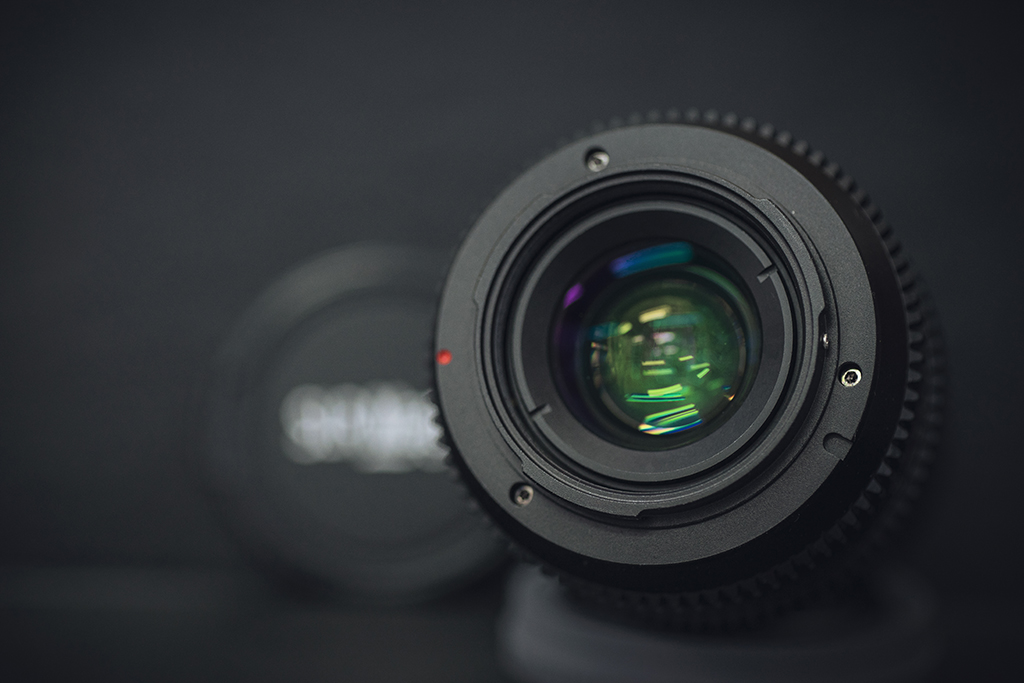
3. OPTICAL PERFORMANCE AND COMPARISONS
3.1. Color rendition
Personally, I don’t care much about the color rendition of a lens since I shoot raw and it’s very easy to control in post-processing. However, I still want to give you some observations about the color rendition of this SLR Magic lens. SLR Magic 25mm lens renders warmer than FD and FE lens and FE lens produces the coolest color tone. I mostly ended up with warmer photos with SLR Magic and cooler colors with FE lens and FD lens is in between if I set the white balance to auto. However, when there are many subject with warm colors like red, FE lens will produce the warmest photos due to the white balance (second photo), but actually if I set fixed temperature, the order I mentioned above never change (first and third photo). All these comparisons were done by switching between As shot (AWB) and Custom (fixed temperature) settings in CameraRaw.
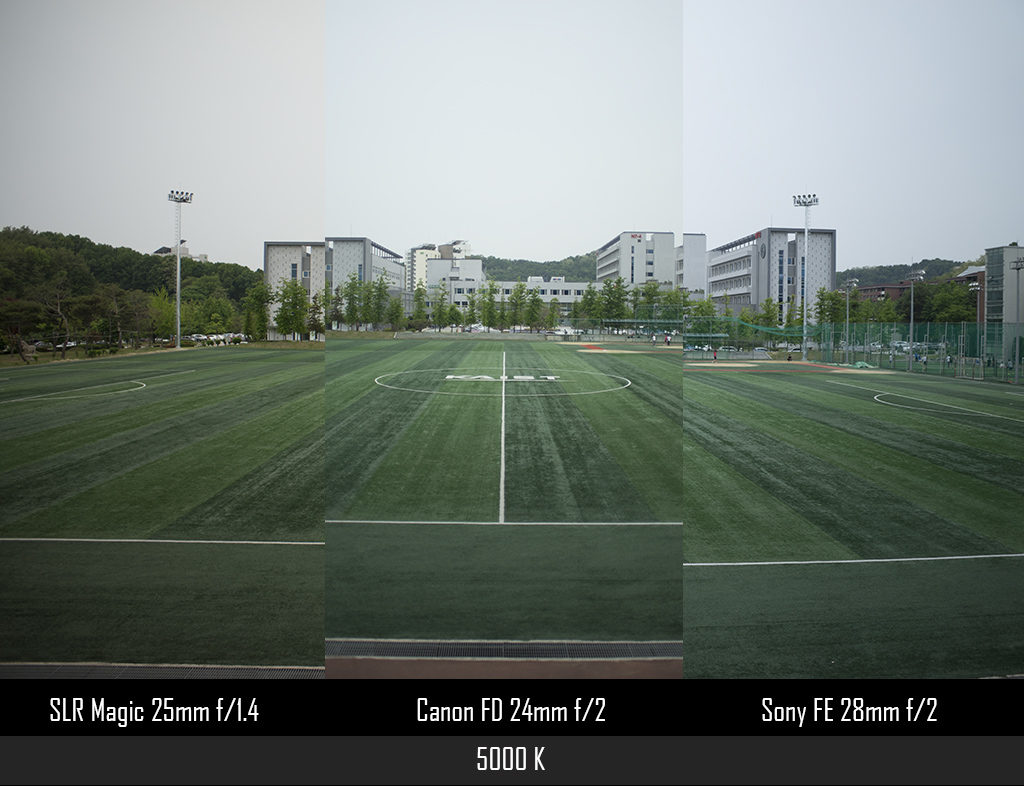
Color rendition at 5000 K
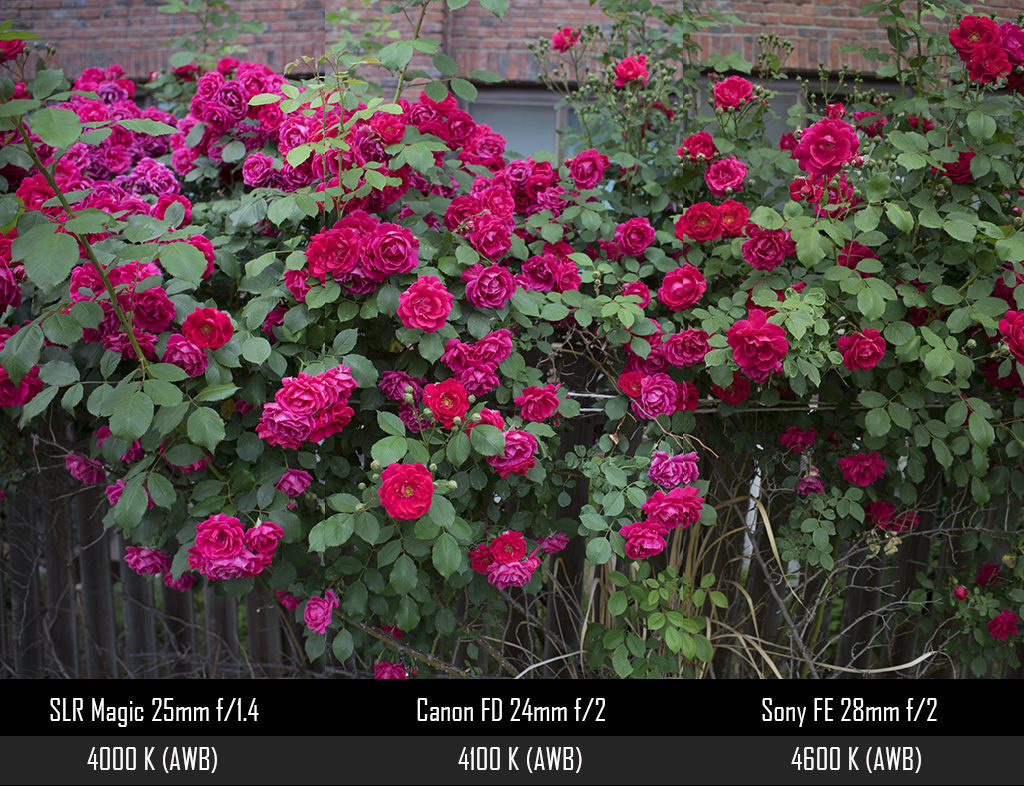
Color rendition using auto white balance
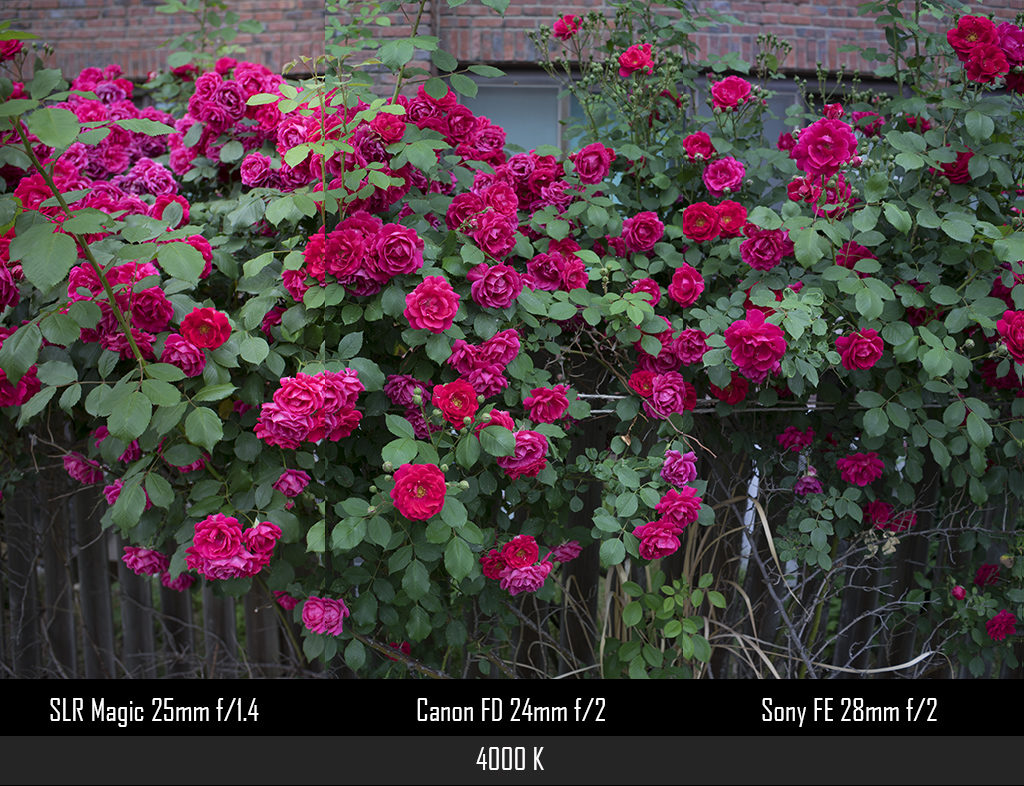
Color rendition when standardize RAW files to 4000 K
3.2. Light transmission
It’s strange for a cine lens to not marking T-stop, but it seems to be common with SLR Magic to use F-stop with all of their cine lenses. I’m really curious to know what is the real T-stop of this lens, but I don’t have any fancy tool to measure that. Instead, what I did was comparing the speed of SLR Magic lens with FE 28mm, which is known with T2.0 at f/2 (DxOMark), by shooting under the condition with uniform light and simple detail (the wall shots). I used aperture priority mode and “Multi” light meter mode. The shutter speeds were the same at f/2 with all three lenses, and surprisingly, at lower f stops, Sony FE actually requires more exposure to get the same brightness. This FE lens was rated at a high T-stop value by DxOMark so I don’t really understand why the value is worse at smaller aperture. Anyway, by estimation, since I don’t have a f/1.4 lens here to compare, SLR Magic should have T1.4 if the shutter speed at f/1.4 is about 1/3200 sec (because it’s a full stop from f/1.4 to f/2), but it needed 1/2500 sec to acquire the same brightness, so the transmission is about 78%, or approx. T1.83. It sounds reasonable, but please correct me if my understanding is not appropriate. Besides, Canon FD 24mm f/2, despite its age, still reaches T2.0! I’m not really sure about this part because it sounds to good to be true.

3.3. Sharpness
I repeated the sharpness tests more than 4 times to make sure I what observed is correct. Also, after several tests, I found out some clues of lens de-centering, so I sent it back to the company in Hong Kong for repair (which I will go into details in the next part) and tested it again once I got it back.
For testing the resolving power of this lens, I compared the center and corner parts of images taken at different apertures, using A7ii with aperture priority mode, auto White balance and fixed ISO values (100-400). As FE 28mm is the only autofocus lens in this test, I switched to manual focus mode and used magnification to adjust the focus point. I didn’t use any filter, hood, and turned off all the image enhancing functions in the camera. In most cases, I fixed the camera position on a tripod and just changed the lens. All of test shots were taken as raw files and I exported jpeg file after turned the sharpen function to zero and removed the auto lens profile correction in the case of FE 28mm.
First, let’s see how they perform at close focus distance (0.5 m). The examined area is marked with red square on the image.

The test scene with examined area marked with red squares
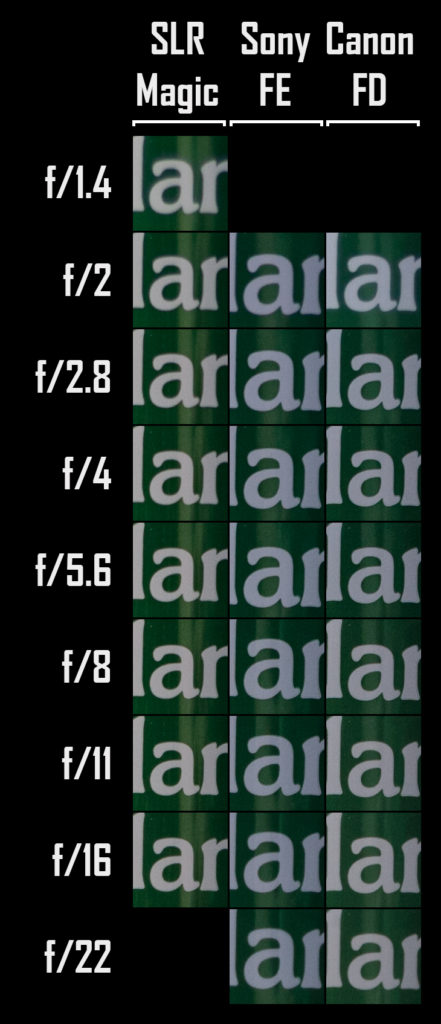
SLR Magic 25mm is quite soft wide open, but to my surprise, from f/2, the center sharpness of this lens is just a bit weaker than FE 28mm and they’re on par from f/5.6. And even more surprise, the old FD 24mm is marginally better than both the others from f/2.8 to f/5.6. The peak of SLR Magic lens is between f/8-f/11 and at f/16 diffraction kicks in, reducing the quality a bit. However, f/2-f/4 range is still good enough if you want to balance the sharpness and shallow DOF. SLR Magic lens doesn’t have f/22 setting while the other two have, and the sharpness at that aperture of both FE 28mm and FE 24mm are still usable and better than SLR Magic at f/2. SLR Magic lens falls in the category of budget lens, but it’s not a cheap and bad lens. I honestly didn’t expect much, as it’s wide and it’s fast, which are the challenges to lens maker. While at f/1.4, the test shows quite soft image produced by SLR Magic lens, it’s totally usable in real life and add certain level of dreamy effect to the image, as you can see in the samples I provide in the end of this review.
To examine the resolution at the edge, I repeated the test, but changed the focus point to the right side of the scene, as indicated in the photo below.
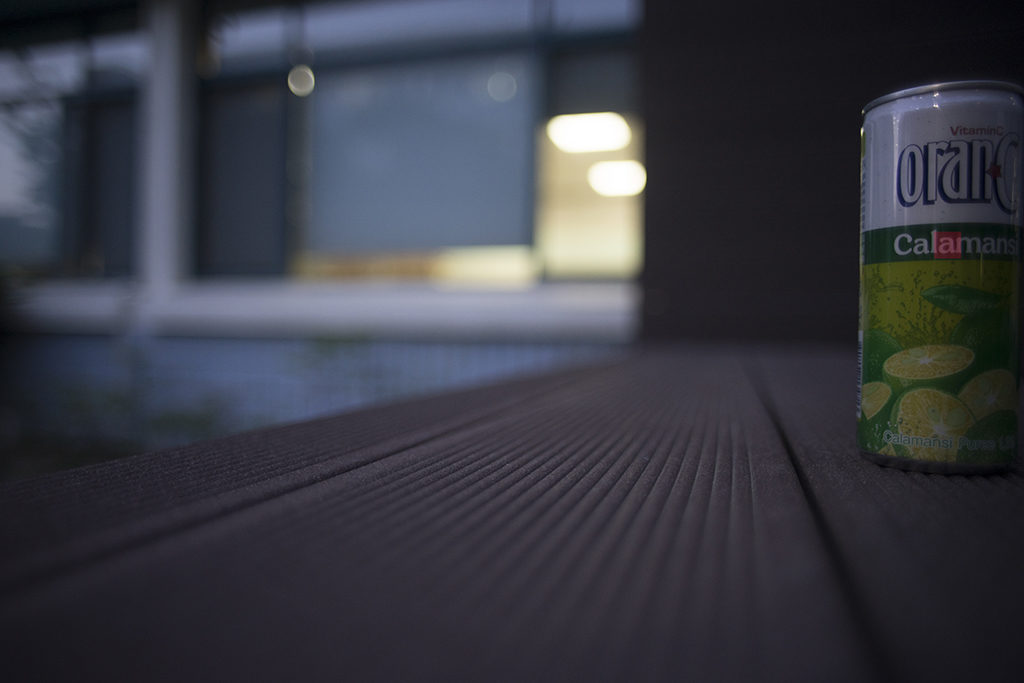
The test scene with examined area marked with red squares
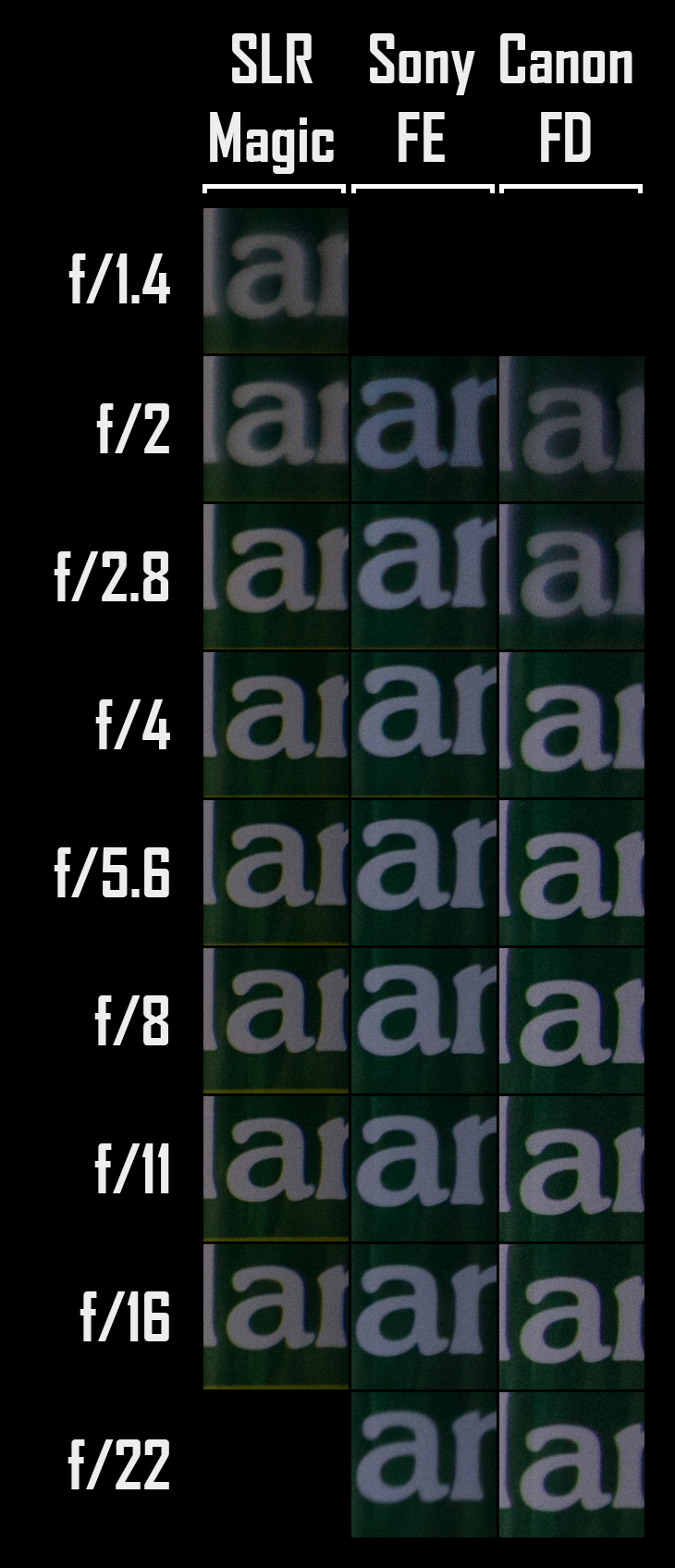
This result is also very interesting, as my initial tests with the decentered SLR Magic lens was much worse. The corner sharpness of the corrected SLR Magic 25mm also exceeded my expectation and it’s almost the same as FE 28mm from f/4 onward, which means it’s a really good performance. My suggestion is avoiding shooting off-center anything with the aperture faster than f/2. FD 24mm struggles until f/4 but then, again, it beats both SLR Magic and FE lenses from f/5.6. Noticeably, at small aperture, FD lens shows some lateral chromatic aberrations, which are absent from the other two.
So at the close focus distance, you can expect SLR Magic 25mm great resolving power from center to edge at f/2.8 or slower aperture, as much as the FE 28mm can do. At faster apertures, SLR Magic is still very usable, but it needs some careful and creative uses.
Next, I wanted to see how these lenses perform when they focus at infinity.
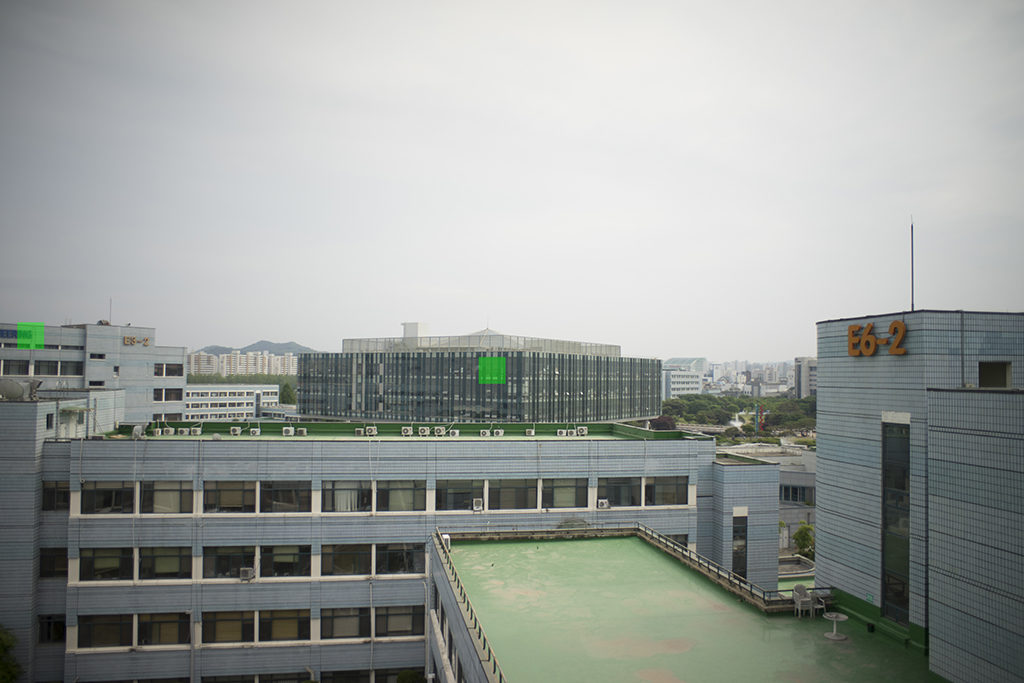
The test scene with examined areas marked with green squares
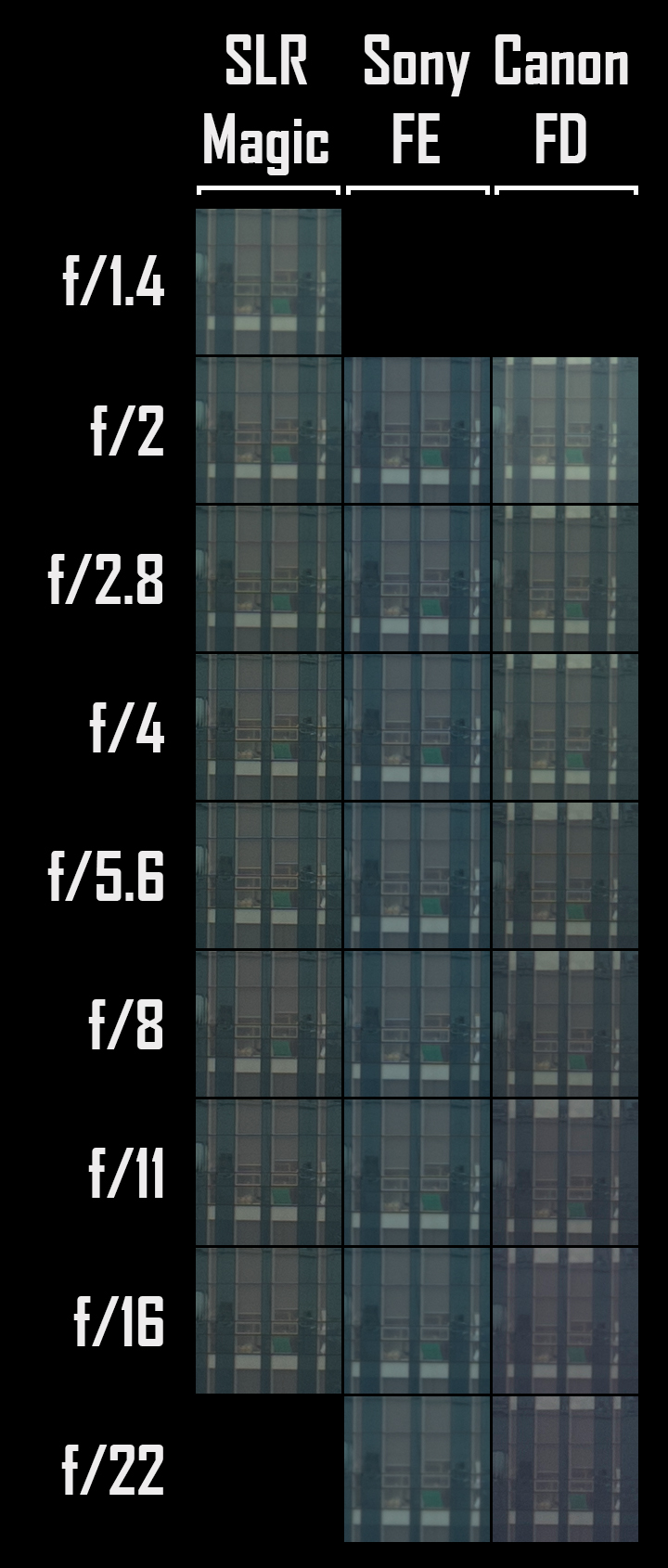
Center sharpness comparison
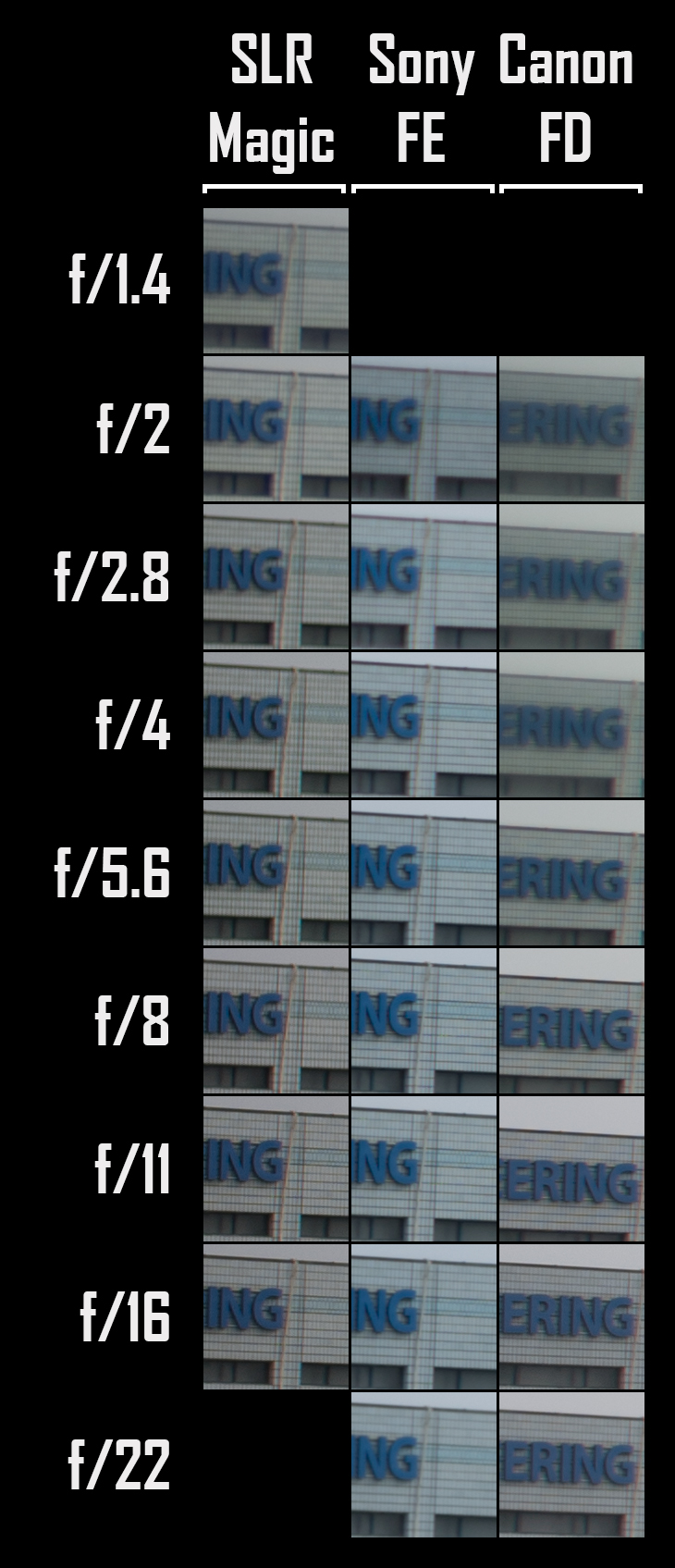
Edge sharpness comparison
The situation here is a quite different from the result at close focus distance. In the center, FE lens has an advantage over the others at wide open, but SLR Magic excels from f/2.8 and is the best of the three until f/16! FE and FD lenses have very similar sharpness but FD image is more washed out due to the lower contrast and a bit haze at long distance. I thought I misfocused FE 28mm as I believed it’s the best, but I didn’t find any area in the image which appears to be sharper than the one in focus. The other thing to consider is I turned off the sharpen function in CameraRaw so the details were actually not as sharp as I usually see with default RAW conversion. The sweet spot of SLR Magic lens is between f/4 to f/11 while at f/2 to f/2.8 is acceptably sharp.
At the edge, SLR Magic is still ahead of FE and FD lenses at the same aperture, even though it’s softer at f/1.4 compared to FE lens at f/2. From f/5.6 to f/11, SLR Magic and FE lens showed very similar performance, but from f/16 it seemed the diffraction had more negative effect on FE lens. FD lens caught up from f/8 to f/16, but the haze still made the images look worse than the other two. Note that the size of the comparing areas are the same, but FD 24mm covered significantly more frame at this distance so the sampling box was chosen closer to the left border of the image.
In this category, SLR Magic is the winner in the f/2.8 – f/16 range and FE lens is the best at fast apertures. FD lens is not far behind the others and at small aperture it’s comparable in term of sharpness, especially at close distance it has the best advantage, but at far distances, lowering contrast or haze is the most serious problem.
3.4. Distortion, field curvature and an issue of de-centering
Photos captured by SLR Magic 25mm f/1.4 have quite strong vignette at f/1.4 (it reduces and keeps at the same medium level from f/2) and medium barrel distortion. The distortion is not very severe that in many cases I didn’t bother correcting it, except shooting architectures or when the straight lines are present. I found that using Voigtlander VM 25mm f/4 Color Skopar profile, it’s easy to correct the distortion and vignette issues of SLR Magic lens. Therefore, I highly recommend shooting raw to fix these issues.

Distortion and vignette of SLR Magic 25mm f/1.4 at 2m focus distance

Correcting distortion and vignette by Voigtlander 25mm f/4 Color Skopar profile
Compared to FE and FD lens, actually FE 28mm has very pronounced barrel distortion (but it’s corrected very well with the lens profile) and FD 24mm has mixed barrel and a little pincushion distortion on the vertical axis, which is more difficult to correct, even though the level of distortion is weaker than SLR Magic.

Compare the distortion level of three lens at f/2
As I mentioned in the sharpness tests, my initial results with SLR Magic were bad that I almost never can achieve sharp image in the corner. I realized that when the center is in focus, it seemed that the corner was out of focus, rather than being soft. There are two possible reasons: field curvature and lens de-centering. I contacted the company and the tech confirmed that I may got a de-centered lens, probably because of the handling during the delivery. To answer exactly, they need to examine the lens carefully using projector, but I can test it myself with a less accurate method. I shot wide open while kept the camera almost in parallel to the ground and focused on a horizontal straight line, in a way that it’s in parallel to a wide side of the frame. As you can see, the focus plane was tilted to the right, which means the right corner will be front-focused while the left corner will be back-focused.
Anyway, I returned the lens and got it fixed very quickly within few days, so I can repeated my tests. In the second photo, it’s easy to see that the problem was gone and actually this lens has a very slight curvy field curvature, it’s almost straight!
I highly suggest every one to use this method and test your wide angle lenses right after receiving, so you can detect this issue very early.
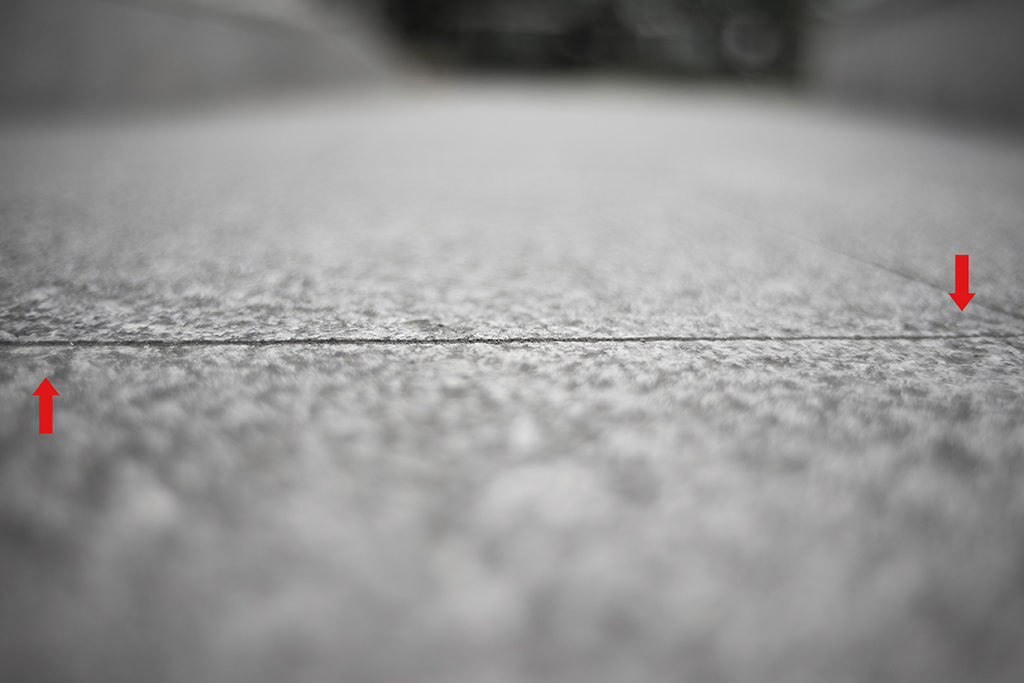
De-centering issue before repairing
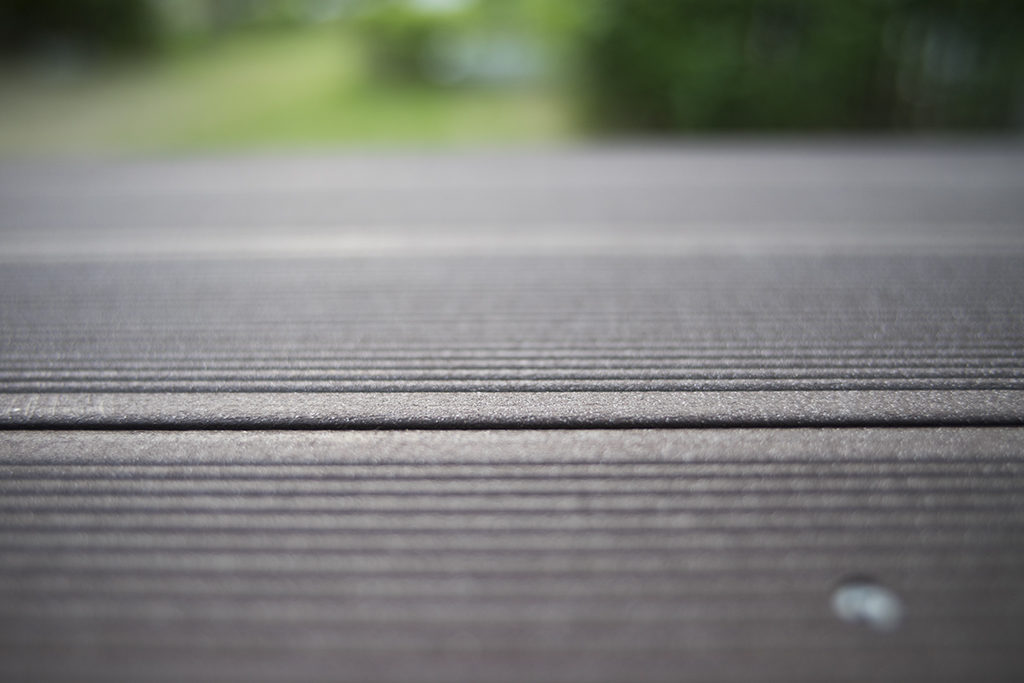
Testing the field curvature after repairing
3.5. Flares and ghosts
A good news is SLR Magic 25mm f/1.4 can resist well to veiling flare or haze, so you won’t see much reduction in the contrast and detail nearby the strong light source, even when you shoot directly to the sun. Many lenses that I’ve tested, veiling flare can lower the contrast of the whole image even when the sun doesn’t shine directly to the lens. With this 25mm lens, you won’t need a hood to work under the strong light. However, anti-ghosting is another story, as there are many, but in a way that can add more cinematic effect to your image. With 11-element design, the reflection of the light on the surface of each element can cause a trace of ghosting, that’s why you can get many with this lens. Sometime it’s annoying but it can be used in a good way depending on your style. Notice that the effect might be different depending on the camera since the sensor reflection partly attributes to the flare (thanks 3D-Kraft for pointing that out). In contrast, FD lens shows a weak resistance against veiling flare but it’s not frequent to show ghosts (except when you stop down to f/16 or less). FE 28mm is the winner with excellent anti-veiling flare and anti-ghosting features, thanks to the Nano coating feature.
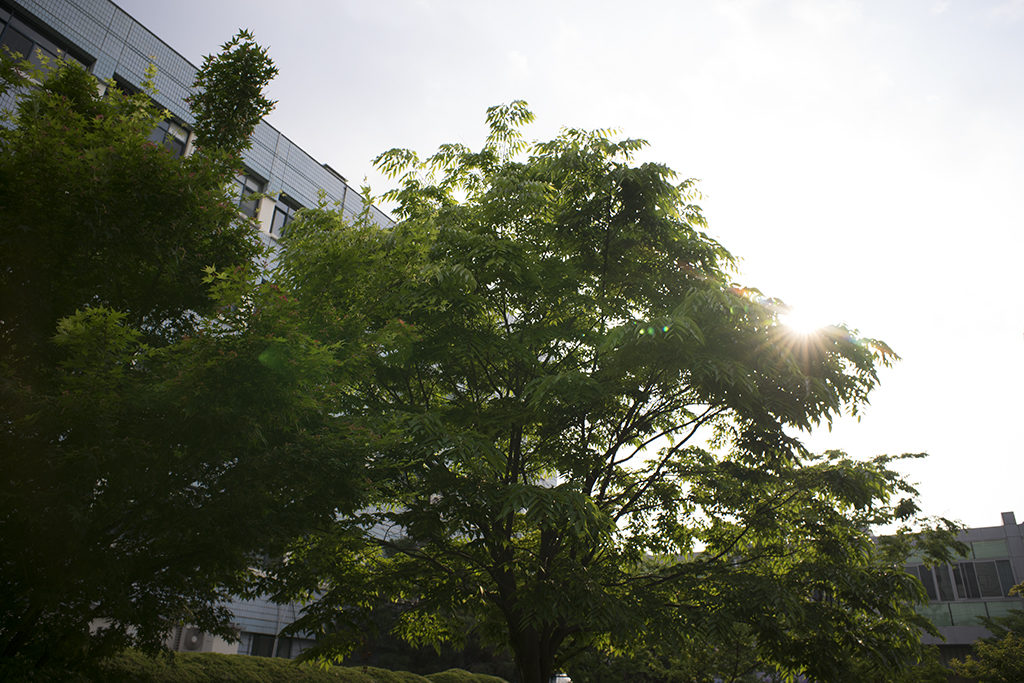
Flare and ghost at f/1.4
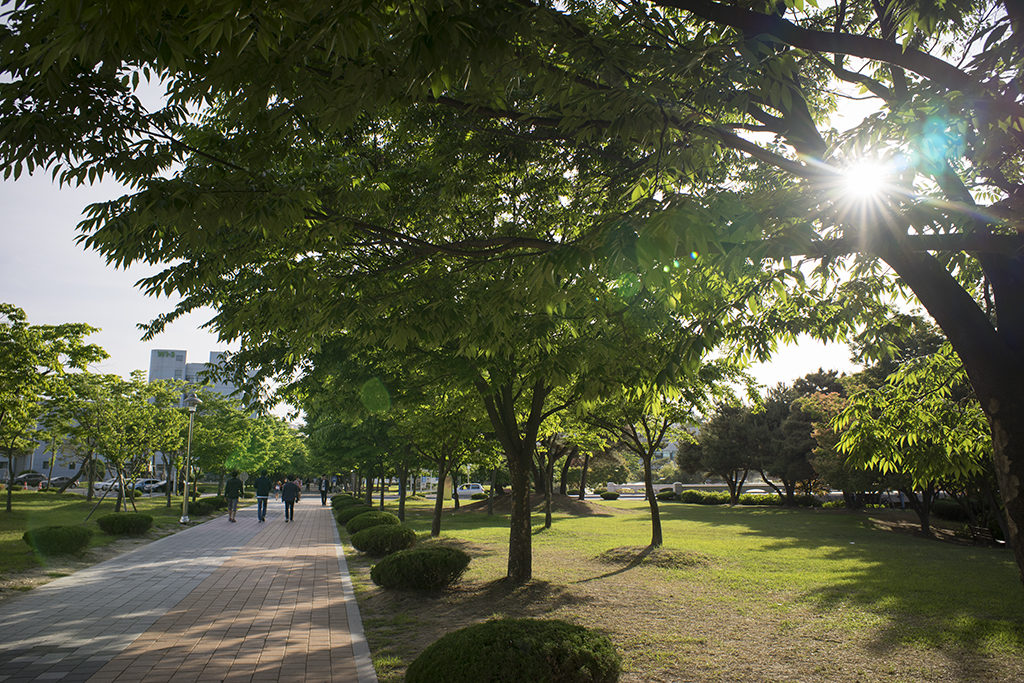
Flare and ghost at f/8 (notice that the color along the star point and the spots on the right corner are more likely sensor reflection)

Flare resistance of three lenses
3.6. Chromatic aberrations
During 2 weeks of using SLR Magic lens, I almost never noticed any lateral chromatic aberration, even with wide open shooting. Only in extreme conditions that I shot directly to the sun, the edges of objects in front of the light source showed some purple fringing. However, this phenomenon is minimized once I stopped down to f/4. In most cases, it’s not the thing you have to worry with this lens.
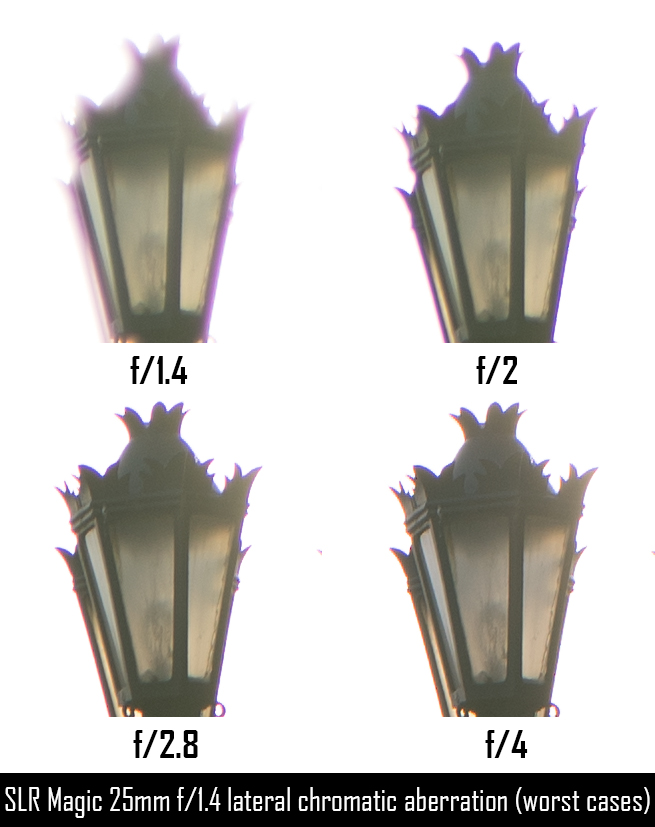
Longitudinal chromatic aberration, even though at very low level, is visible when I shot flat surfaces at very small angle. And this issue can be fixed when you use f/2.8 or lower aperture settings (see the photo below). These level of corrections is amazing with such a compact lens that lacks special elements.
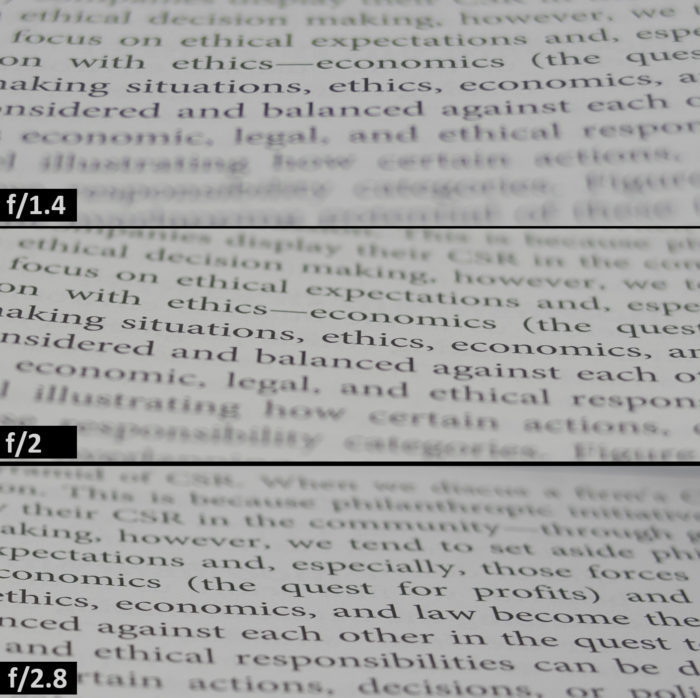
Longitudinal chromatic aberration of SLR Magic 25mm f/1.4
3.7. Bokeh characteristics
It’s quite rare these days to see that many aperture blades! Modern lenses are normally use up to 9 blades, which I don’t really understand why. I’ve used many German and Russian manual focus lenses with many aperture blades and the bokeh are always lovely round at every apertures. And that’s what we get with SLR Magic lens, it produces round bokeh disks from the center to the corner of the images. That’s very beneficial for video recording, too.
Beside the round bokeh disk, the out of focus area produced by this lens is quite pleasing and very smooth at close focus distance as you can see in the sample photos I provided in the end of this review.

3.8. Starburst / Star effect
It’s important for landscape / nightscape photographers to know how the lens can produce star effect at small apertures. Thanks to the 13 aperture blades, SLR Magic lens can produce 26-point star from f/8 and as early as f/4 you still can get star effect, even though the star is not as sharp. The good thing is the star points are quite even and symmetric, but as a matter of taste, some people might not prefer that many star points. In the image below, the star effect is observed at the mid-frame areas of an image as marked below.
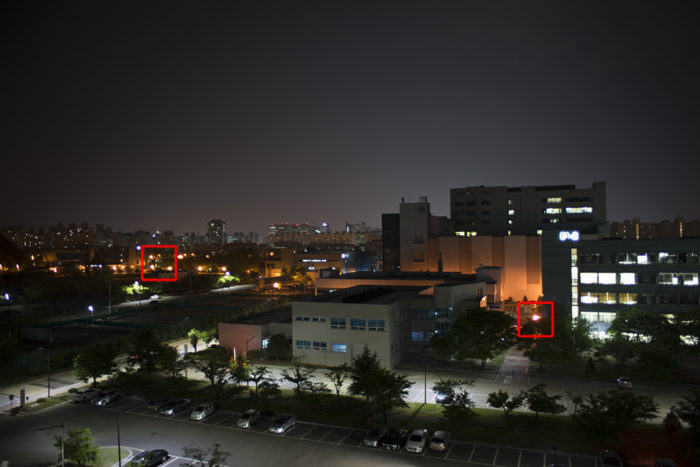
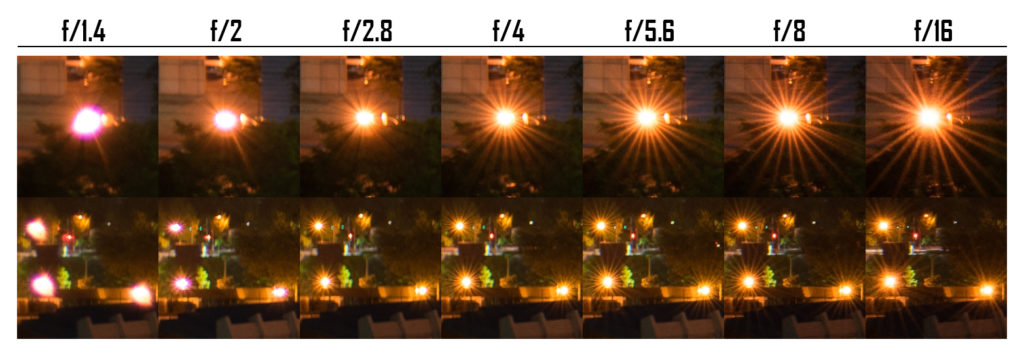
3.9. Lens breathing
As a cine lens, it’s important to know how well the lens can control the breathing issue. The bad news is this lens breaths quite strongly. As I measured, the angle of view (horizontal) at minimum focus distance is about 88.6% the angle of view at infinity focus.

3.10. Coma / Comatic aberration
Coma or comatic aberration causes the smeared details in the corner of the image, and it’s important to know with astrophotographer. This wide and fast SLR Magic lens is definitely of interest for that purpose so I want to see how well it can control coma issue. Unfortunately, in the city I’m living, it’s impossible to photograph stars (nicely) due to the light pollution. However, I still can evaluate the coma level by shooting light dots from the city at far distance.
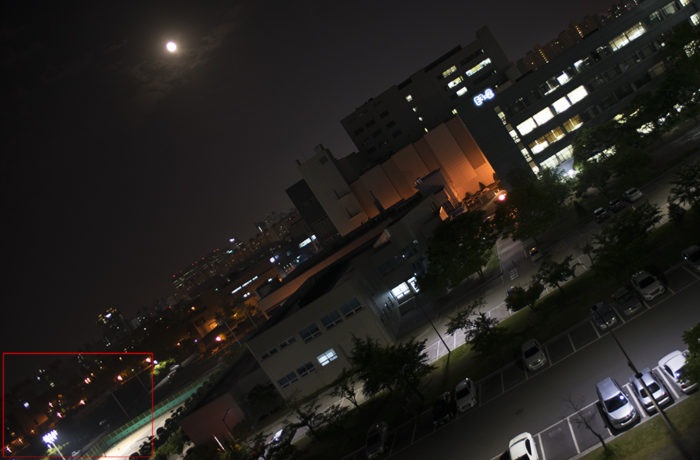
At f/1.4, the light spots were quite smeary at the corner, with some lateral chromatic aberrations. However, stopping down to f/2.8, the issue was minimized and even at f/2 it’s hard to notice the coma issue when you view the whole large image. Maybe someone else can shoot a nice star photo to confirm that but I believe that this lens is totally capable of shooting astro photos.
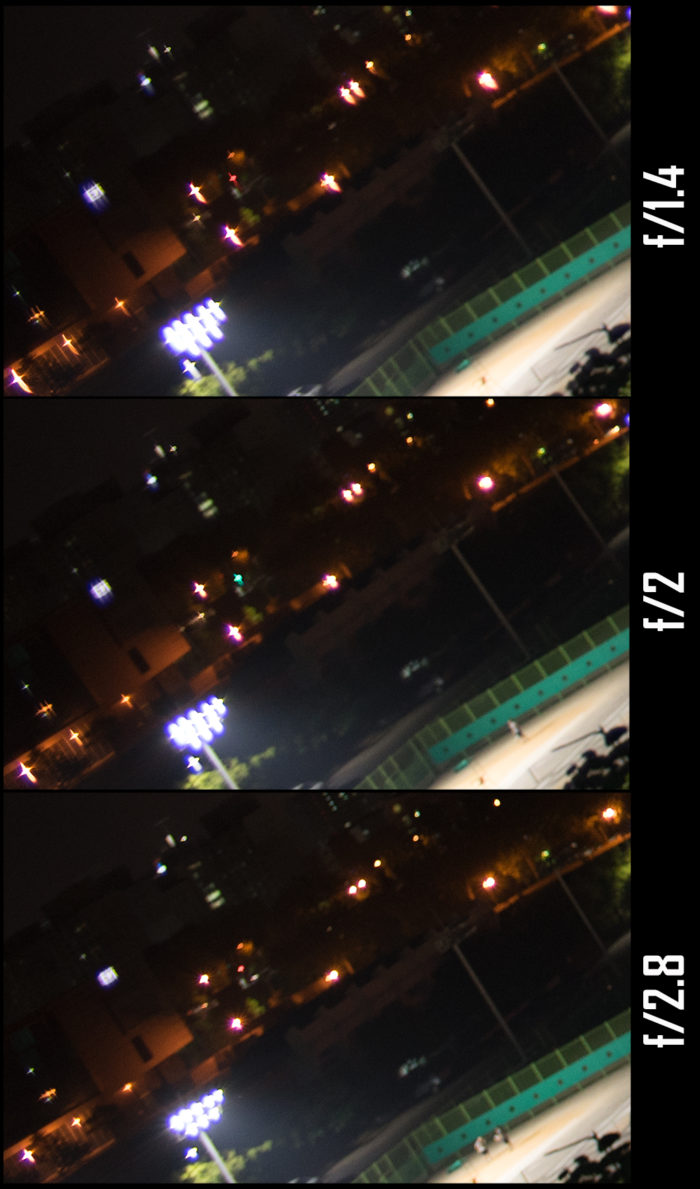
3.11. The use with APS-C camera (A6300)
Of course, this lens can be used with APS-C camera like A6000, A6300, A6500 and NEX series. On APS-C sensor, the angle of view of this lens is equal to a 37.5mm lens on a full frame camera. The good thing is you can have excellent resolution from center to the corner since it’s only the center to mid-frame part of the frame that this lens can cover, and the lens still sucks light in at f/1.4. This lens can focus quite close to a object and I can get more magnification ratio with an APS-C camera, so it’s a great combo to take close-up photos or product shots. Moreover, the vignette issue and some lateral chromatic aberrations at the far corner will be gone, too. I made a quick comparison of this lens on my A6300 versus Konica Hexanon AR 40mm f/1.8 (which is a very nice budget lens) on A7ii to see how the frames are different. To shoot the same image frame, this SLR Magic lens is similar to a 37.5mm f/2.1, as you can notice the Konica f/1.8 lens has smoother bokeh with its shallower DOF.
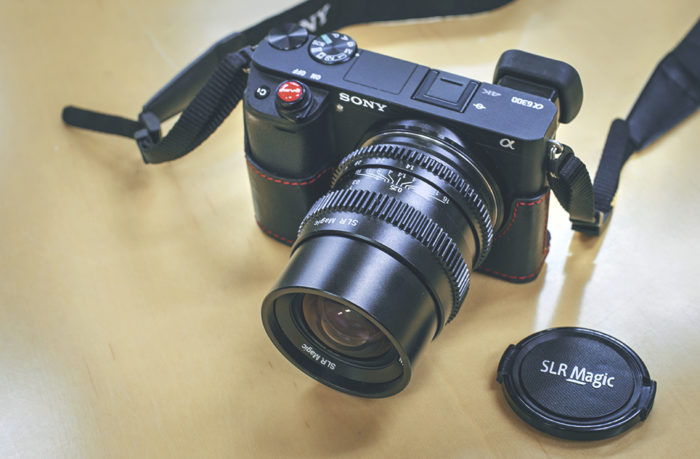
The thing I don’t like while I used SLR Magic 25mm lens on A6300 is it’s even more unbalanced than on A7ii: the camera can’t stand straight up and I can feel the weight on the front side very easily. It will not be a problem when you use this lens on a gimbal, I guess.

4. SAMPLE PHOTOS
A picture is worth a thousand words, without sample photos my review is meaningless. Here I provided some of my best shots during the time I reviewed this lens. All photos were taken as RAW files and proceeded in CameraRaw and Photoshop to match my style. If you want to get straight-out-of-camera photos, please contact me.
If you click to a photo, it will lead you to my high resolution image on Flickr.
A7ii | 25mm | f/1.4 | 1/3200 sec | ISO 100
A7ii | 25mm | f/1.4 | 1/1600 sec | ISO 100
A7ii | 25mm | f/2 | 1/100 sec | ISO 100
A7ii | 25mm | f/2 | 1/200 sec | ISO 100
A7ii | 25mm | f/2 | 1/60 sec | ISO 100
A7ii | 25mm | f/2 | 1/60 sec | ISO 100
A7ii | 25mm | f/2.8 | 1/400 sec | ISO 100
A7ii | 25mm | f/2.8 | 1/25 sec | ISO 100
A7ii | 25mm | f/2.8 | 1/320 sec | ISO 100
A7ii | 25mm | f/2.8 | 1/800 sec | ISO 100
A7ii | 25mm | f/4 | 1/25 sec | ISO 100
A7ii | 25mm | f/4 | 1/50 sec | ISO 100
A7ii | 25mm | f/4 | 1/125 sec | ISO 100
A7ii | 25mm | f/4 | 1/1000 sec | ISO 100
A7ii | 25mm | f/4 | 1/250 sec | ISO 100
A6300 | 25mm (37.5mm equivalent)| f/4 | 1/50 sec | ISO 250
A7ii | 25mm | f/8 | 1/320 sec | ISO 100
A7ii | 25mm | f/4 | 1/100 sec | ISO 400
A7ii | 25mm | f/8 | 1/60 sec | ISO 100
5. CONCLUDING REMARKS
With $399, even though I don’t say this SLR Magic 25mm f/1.4 Cine lens is a bang for the bucks, it’s definitely among the best choices you have with limited budget. If you want to have the highest quality and money is not a limiting factor, get the Batis 25mm f/2 or FE 24-70mm f/2.8 GM lens. There is not much that I can complain about this lens, it’s better than my FE 28mm f/2 in some important aspects. The disadvantage of this lens is if you shoot jpeg, you won’t get any correction in camera and it’s not as good as FE 28mm. but if you shoot raw, there is not much advantage that the FE lens can benefit you, except the weight and AF.
I had a quick discussion through e-mail with SLR Magic before sending them the lens for repairing, and they reminded me that the lens was designed to be compact, hence it has some limitations like distortion and vignette. However, the company had done a good job with this lens and it exceeded my expectations in every ways. I enjoy shooting with this lens like an upgraded version of a legacy manual focus glass and it will have a place in my bag when I travel.
What a pity that I’m not really into cinematography so I can’t share proper a review on the usage of this lens for recording, but I’m sure other people have done that and you can find them on the internet.
The last thing to mention is I was really impressed with the service from SLR Magic, they kept in touch, replied me very promptly, and very quick in delivery and repairing. I hope that the company can do the same thing with every customers.
Thanks for reading!
